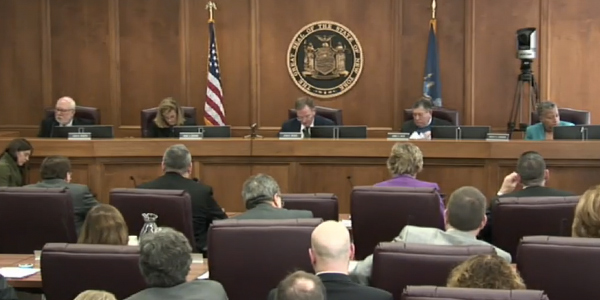By Michael Kuser
The New York Public Service Commission on Thursday performed some heavy regulatory lifting intended to help the state achieve its ambitious clean energy goals, committing an additional $2 billion to energy efficiency and building-electrification programs. It also created an index renewable energy credit that pays for the environmental attributes of a solar or wind farm (18-M-0084, 15-E-0302).
The energy efficiency order “puts us on a path as a state to save at meaningful levels, and saving is the way of going after the resource we don’t use, which is always the best resource,” PSC Chair John B. Rhodes said. “It leans into the [Climate Leadership and Community Protection Act], taking action now at high levels of achievement, at high levels of distributing that achievement equitably.”
Among other targets, the CLCPA (A8429) signed into law last July aims to raise the state’s energy efficiency savings to 185 trillion BTU by 2025 and greenhouse gas emission reductions by 85% by 2050. (See Cuomo Sets New York’s Green Goals for 2020.)
Various state agencies will coordinate the investments to achieve the new energy efficiency and electric heat pump targets for investor-owned utilities, investments estimated at $6.8 billion from now through 2025.
Commissioner Diane Burman stood alone on the five-member commission in voting against the energy efficiency measure. She urged fiscal and fiduciary prudence and recalled that at the PSC’s November 2019 session, she voted against reallocating uncommitted funds to the New York State Energy Research and Development Authority to administer clean energy programs. (See “CES Budget for 2020,” NYPSC OKs Rebuilding Upstate Tx Lines.)
“I have been a consistent ‘no’ when we are looking to repurpose and reallocate uncommitted funds,” Burman said. “It really begs the question to me: Why not reduce those surcharges or at least be more mindful of those programs in total from the beginning?”
A wide coalition of environmental groups endorsed the move, led by the Natural Resources Defense Council.
“Speed is of the essence when it comes to bending the curve on climate pollution,” Samantha Wilt, NRDC senior policy analyst for climate and clean energy, said in a statement. “There is no cheaper or faster way to do that than investing in energy efficiency. This order also has massive job-creating potential and will improve New Yorkers’ homes and businesses, making them more comfortable, healthier and less polluting.”
Enhancing Tier I RECs
In its order modifying Tier 1 renewable procurements, the commission directed NYSERDA to include an additional option for bidders to offer an indexed REC price in future Renewable Energy Standard (RES) solicitations, beginning with this year’s.
The American Wind Energy Association and the Alliance for Clean Energy New York last March filed a petition asserting that an indexed REC — based on a reference market index that will change monthly over the life of a RES contract — would serve as a hedge against market volatility, lower the financing costs for renewable generators, and provide lower costs and less volatile prices for ratepayers.
“Our decision today will benefit renewable energy developers by reducing their risks while also lowering customer costs,” Rhodes said.
The commission noted that adopting an indexed REC structure will require changes to the RES program, including revisions to the methodology for calculation of its annual Tier 1 REC price associated with sales to load-serving entities for both fixed-price and indexed REC payments.
The order directs NYSERDA and Department of Public Service staff to file an implementation plan within 90 days but notes that approval of the plan is not required prior to issuance of an index REC solicitation.
The Advanced Energy Economy (AEE) Institute commented that an indexed REC could cause more volatility in computing the environmental value because the calculation method is tied to the Tier 1 REC price. It suggested that environmental value might vary by zone and that the social cost of carbon could factor into setting the environmental value if the state implements the NYISO carbon pricing proposal.
The commission found “appropriate” AEE’s suggestion to hold a stakeholder process within the Value of Distributed Energy Resources proceeding to consider the issues (17-01277). (See NYPSC Refines Value Stack, Boosts Community DG.)
Burman, again the only commissioner in opposition, said she voted against the measure “because we already have had experience in these solicitations, in 2018 and 2019, that were robust. We got a lot, we were oversubscribed, so I don’t fear that somehow we need to do this to make the developers be a part of the solicitation.
“My biggest fear is, when I look to NYSERDA, I don’t see enough analysis, and I’m persuaded by New York City’s comments that there should be more substantive, quantitative analysis done to ensure that we are carefully evaluating the risk.”
Susanne DesRoches, of the New York City Mayor’s Office of Recovery and Resiliency, argued in an Oct. 2, 2019, filing that it “is essential to ensure that the potential benefits of lower REC prices are substantial enough to mitigate the added risks to customers that result from moving to an indexed pricing procurement mechanism which shifts project risk away from the developer and onto customers.”
“Given that there are nearly half a million low-income families in New York City who are over the state’s target for spending on energy bills today, it is imperative that customers do not become even more energy cost-burdened as a result of a switch in REC procurement methodologies,” DesRoches said.





